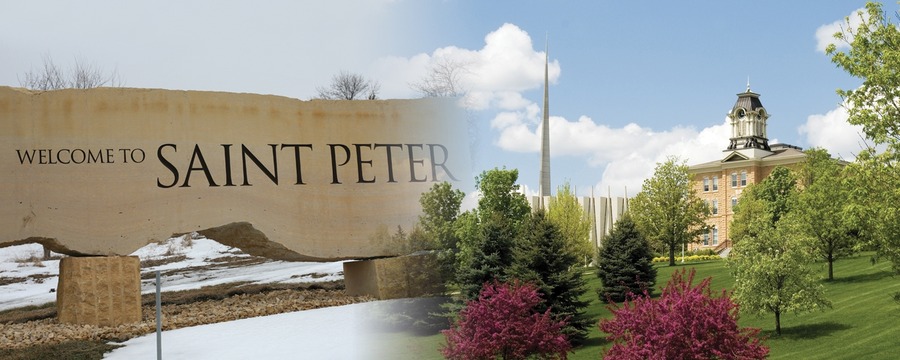It’s casually referred to as the “town and gown” relationship. How does the presence of a college impact the surrounding community? How can the community become an asset to the college and its students and vice versa? How can the two work together to build a relationship that is beneficial to both parties?
Those are the questions that Jeffrey Rathlef is seeking to answer. Rathlef joined Gustavus in July 2008 as the College’s director of community service and service learning and one of his major initiatives started to take shape in January.
During Gustavus’s January Interim Experience, Rathlef offered a course called “Community Partnership: Building Reciprocity from the Grassroots.” The goal of the students enrolled in the course was to research and evaluate the current dynamic behind service and learning activities between Gustavus and St. Peter and then develop a proposal with recommendations on how the two parties might collectively facilitate service and learning through partnership.
“Really what we are trying to get at is ‘what could we achieve with a more intentional, close-working relationship with St. Peter?’” Rathlef said.
The students in Rathleff’s class conducted interviews and formed focus groups with individuals in the Gustavus and St. Peter communities to evaluate the current situation. Questions were asked such as ‘what is working?’ and ‘what areas need improvement?’ Much of their research was generated through focus groups facilitated by the social networks of eight “community partners” who facilitated students’ access to the grassroots in St. Peter.
Those community partners included Paul Peterson, principal of St. Peter Middle and High Schools; Annette Engeldinger, teacher at St. Peter Middle and High Schools; Jane Timmerman, director of the St. Peter Community Center; Blake Dirks, optometrist at St. Peter Eye Clinic; Dave Nieman, owner of Arrow Ace Hardware; Ben Leonard, director of the St. Peter Historical Society; Maria Alvarez, Mexican-American social worker; and Erika Reckling, youth pastor at Trinity Lutheran Church.
“The reception from the community members has been very positive,” Rathlef said. “It’s my sense that a lot of people have really appreciated being asked these types of questions as far as how we want to work together in the future.”
The final proposal is a 21-page document that includes several recommendations on how Gustavus and St. Peter might move forward on future collaborations.
One of the recommendations involves the formulation of a “partnership council” that would advise and facilitate future proposals of collaboration. The vision of the Gustavus students is for the council to include a Gustavus student and faculty member, a St. Peter High School student and administrator, a city of St. Peter employee, a St. Peter Chamber of Commerce member, a Nicollet County employee, a service organization member, and a member with connections to underrepresented groups. Rathlef and Gretchen Taylor, the director of the St. Peter Volunteer Center would also serve on the council.
Other recommendations outlined in the proposal include securing funding to support the Council over the long term and making reciprocity a guiding principle of the Council.
“It’s exciting that this is actually coming to fruition. A lot of things you work on in college are hypothetical projects, but we’re really producing something tangible so that’s really exciting,” said sophomore Hannah Nordell, one of the five students who took Rathlef’s January course. “The community partners that we are working with are really excited about what we’re doing so it’s nice to have members of the community behind us.”
Along with the satisfaction of being able to develop a final proposal, the students in Rathlef’s class were also able to learn what it means to be in partnership with somebody, what the principles of a strong partnership are, and what makes a true partnership work.
In their proposal, the students spent time talking about the characteristics of partnerships and listed things like the sharing of common goals, reciprocity, using active communication and feedback, intentionality, making sure everyone’s voice is heard, and the development of relationships.
Carrying Out the Proposal
Nordell is one of two students along with junior Tesia Kubat who have internships with the Gustavus Community Service Center during the spring semester. Nordell and Kubat will be assisting Rathlef in carrying out the recommendations of the final proposal through a pilot project of the partnership council.
If successful, the project has a chance to positively impact members of both the Gustavus and St. Peter communities. By engaging themselves in the St. Peter Community, Gustavus students have the opportunity to gain hands-on experience that could prove to be valuable to potential employers. The partnership holds the potential for Gustavus faculty and students to benefit from a standing community counterpart charged with assisting them and supporting community service and service-learning proposals, projects, and programs in a meaningful and purposeful manner in the local community.
Conversely, St. Peter will gain access to a fairly substantial volunteer base, as about half of Gustavus’s 2,500 students participate in some sort of volunteer work every year. The partnership seeks to empower the local St. Peter community in having a greater voice and shared oversight in helping determine what civic engagement from Gustavus should and could entail in the local setting.
“It is good practice for campuses and communities to periodically re-visit and re-evaluate their relationships. For us, this endeavor has confirmed the strength of the relationship base, and the potential and opportunity at hand for moving those relationships toward deeper, more reciprocal partnerships,” Rathlef said. “My hope for an outcome is that a partnership council itself would embody the values of effective partnership at its very core and continually address the on-going question of ‘how do we want to “be” and interact with each other?”

Leave a Reply
You must be logged in to post a comment.